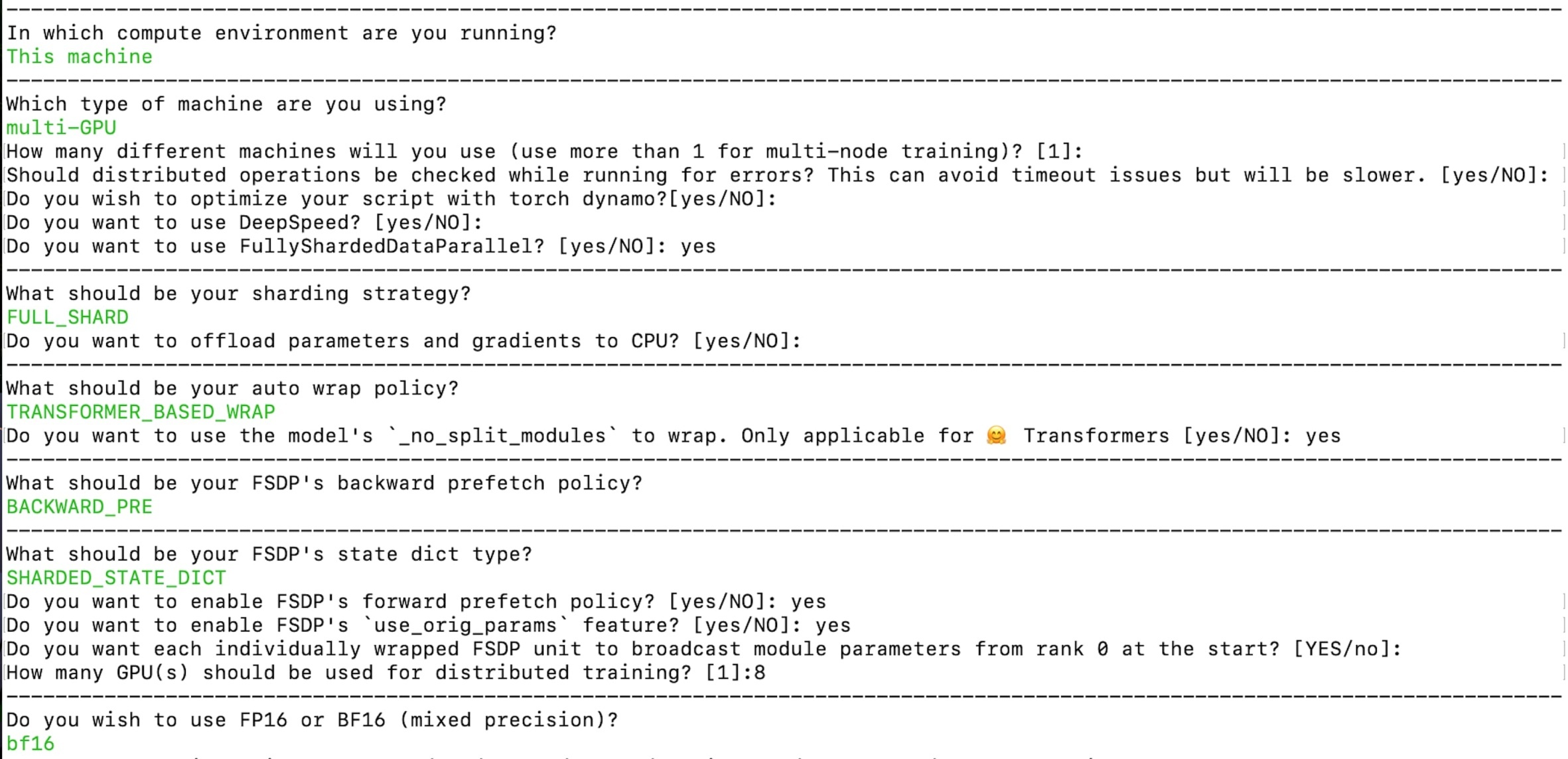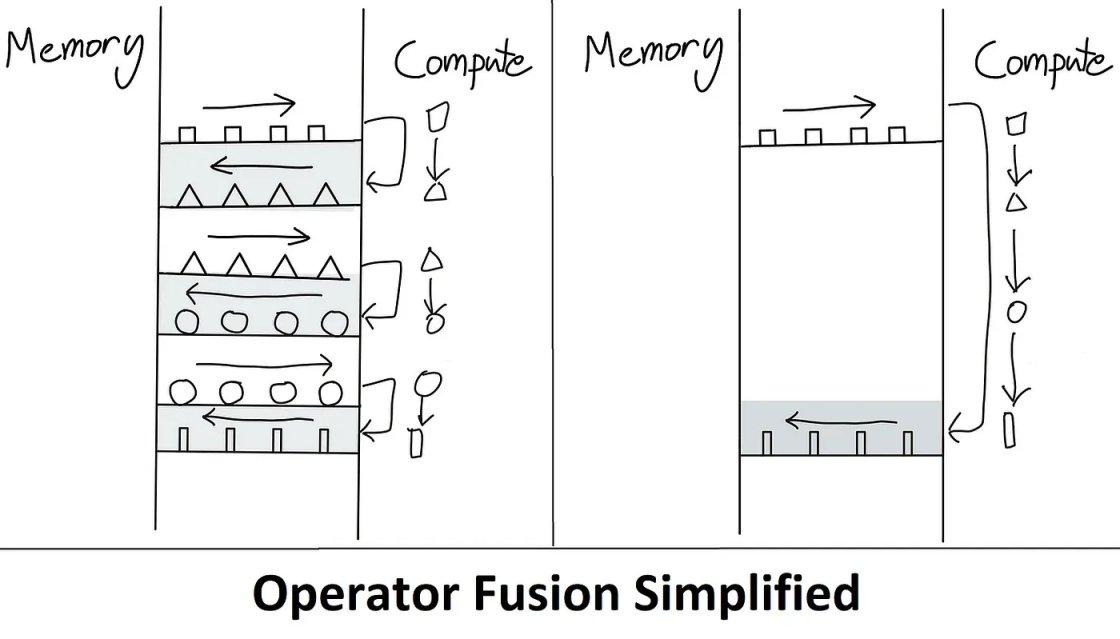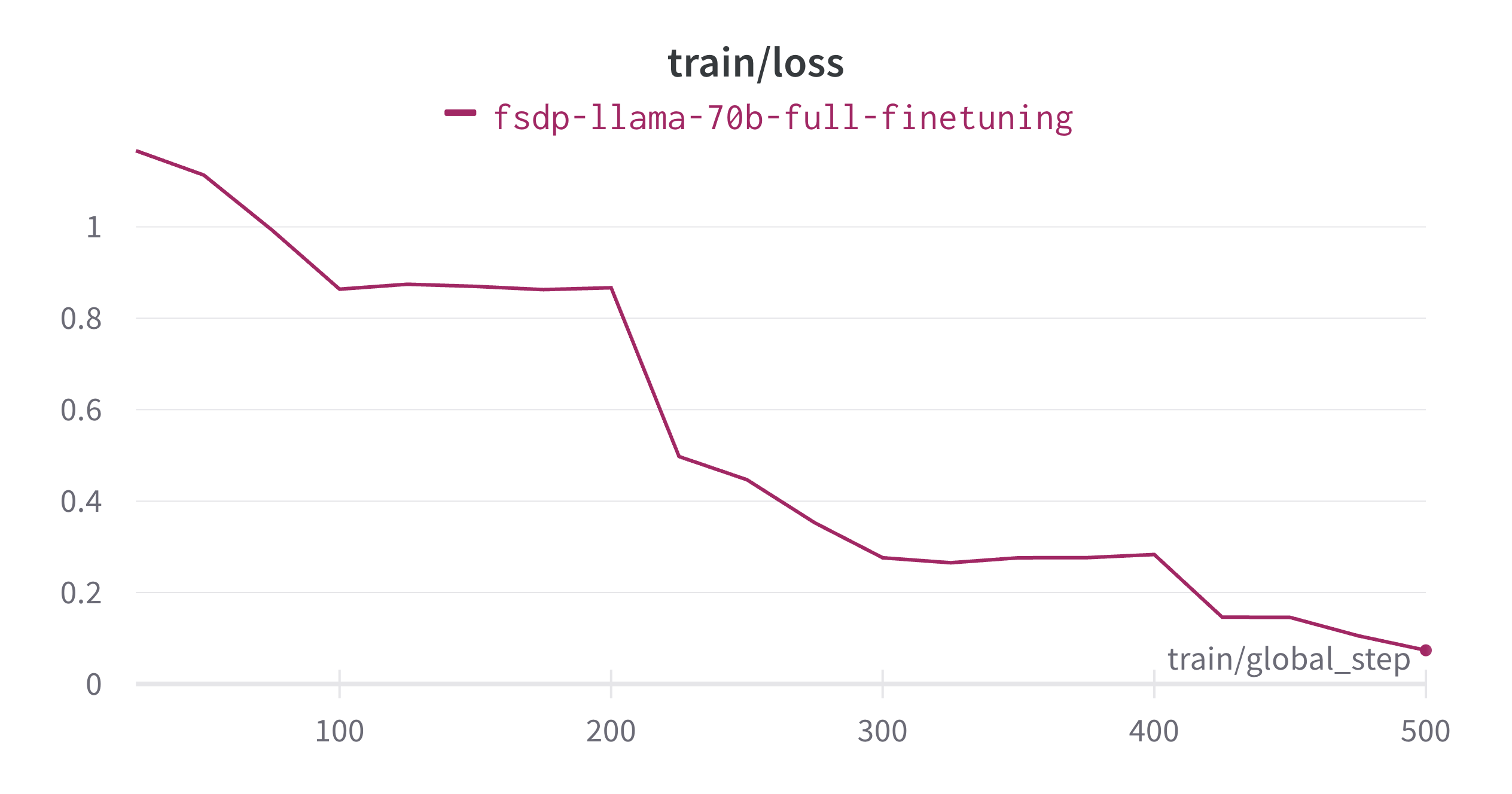引言
通过本文,你将了解如何使用 PyTorch FSDP 及相关最佳实践微调 Llama 2 70B。在此过程中,我们主要会用到 Hugging Face Transformers、Accelerate 和 TRL 库。我们还将展示如何在 SLURM 中使用 Accelerate。
完全分片数据并行 (Fully Sharded Data Parallelism,FSDP) 是一种训练范式,在该范式中优化器状态、梯度和模型参数都会被跨设备分片。前向传播时,每个 FSDP 单元执行 all gather 以获取完整的权重,然后用它们进行计算并在计算后丢弃掉其他设备的分片。随后是反向传播,然后就是损失计算。反向传播时,每个 FSDP 单元执行 all gather 操作以获取完整的权重,并执行计算以获得本地 batch 的梯度。这些梯度通过 reduce scatter 在设备上进行均值计算并分片,这样每个设备都可以更新其对应分片的参数。有关 PyTorch FSDP 的更多信息,请参阅此博文: 使用 PyTorch 完全分片数据并行技术加速大模型训练。
使用的硬件
节点数: 2,至少 1 个节点每节点 GPU 数: 8GPU 类型: A100GPU 显存: 80GB 节点内互联: NVLink 每节点内存: 1TB 每节点 CPU 核数: 96 节点间互联: AWS 的 Elastic Fabric Adapter (EFA)
微调 LLaMa 2 70B 面临的挑战
在尝试使用 FSDP 微调 LLaMa 2 70B 时,我们主要遇到了三个挑战:
FSDP 会先加载整个预训练模型,然后再对模型进行分片。这样就意味着节点内的每个进程 (即 rank) 都会加载整个 Llama-70B 模型,因此需要 7048 GB ~ 2TB 的 CPU 内存,这个算式中 4 是每个参数所需字节数,8 是每个节点的 GPU 数。这会导致 CPU 内存不足,进而导致进程终止。
使用 FULL_STATE_DICT 来保存完整中间检查点并将其卸载至 rank 0 的 CPU 内存中需要花费大量时间,且由于在此期间通信库需要无限期挂起等待保存完成,因此经常会导致 NCCL 超时错误。然而,完全关掉这个选项也不好,因为在训练结束时我们需要保存完整的模型状态字典,而不是 FSDP 式分片的状态字典。
我们需要提高速度并减少显存使用,以加快训练并节约计算成本。
下文,我们主要讨论如何一一解决上述挑战,最终微调出一个 70B 的模型!
先列出重现结果所需的所有资源:
代码库: https://github.com/pacman100/DHS-LLM-Workshop/tree/main/chat_assistant/training,代码中包含了使能 flash 注意力 V2 的热补丁
FSDP 配置文件: https://github.com/pacman100/DHS-LLM-Workshop/blob/main/chat_assistant/training/configs/fsdp_config.yaml
SLURM 启动脚本 - launch.slurm : https://gist.github.com/pacman100/1cb1f17b2f1b3139a63b764263e70b25
模型: meta-llama/Llama-2-70b-chat-hf
数据集: smangrul/code-chat-assistant-v1 (混合了 LIMA 和 GUANACO 数据集,且已转换为训练所需的格式)
准备工作
首先按照 此步骤 安装 Flash Attention V2。然后,安装最新的 PyTorch nightly (CUDA ≥11.8)。接着,根据 此文件 安装其余依赖软件。在本文中,我们是从主分支安装 🤗 Accelerate 和 🤗 Transformers 的。
微调
应对挑战 1
PR 25107 和 PR 1777 解决了第一个挑战,且无需用户侧更改任何代码。主要做的事情如下:
在所有 rank 上创建无权重的空模型 (使用 meta 设备)
仅在 rank 0 上将状态字典加载至模型
其他 rank 仅对 meta 设备上的参数执行 torch.empty(*param.size(), dtype=dtype)
因此,只有 rank 0 上加载了完整的模型及权重,而所有其他 rank 上的权重是空的
设置 sync_module_states=True ,以便 FSDP 实例在训练开始之前将权重广播到各 rank
下面是在 2 个 GPU 上加载 7B 模型的输出日志片段,它测量了各个阶段内存的消耗及其加载的模型参数量。我们可以观察到,在加载预训练模型时,rank 0 和 rank 1 的 CPU 峰值内存分别为 32744 MB 和 1506 MB 。因此可知,仅有 rank 0 加载了预训练模型,这就实现了 CPU 内存的有效利用。你可在 此处 找到完整日志。
accelerator.process_index=0 GPU Memory before entering the loading : 0accelerator.process_index=0 GPU Memory consumed at the end of the loading (end-begin): 0accelerator.process_index=0 GPU Peak Memory consumed during the loading (max-begin): 0accelerator.process_index=0 GPU Total Peak Memory consumed during the loading (max): 0accelerator.process_index=0 CPU Memory before entering the loading : 926accelerator.process_index=0 CPU Memory consumed at the end of the loading (end-begin): 26415accelerator.process_index=0 CPU Peak Memory consumed during the loading (max-begin): 31818accelerator.process_index=0 CPU Total Peak Memory consumed during the loading (max): 32744 accelerator.process_index=1 GPU Memory before entering the loading : 0accelerator.process_index=1 GPU Memory consumed at the end of the loading (end-begin): 0accelerator.process_index=1 GPU Peak Memory consumed during the loading (max-begin): 0accelerator.process_index=1 GPU Total Peak Memory consumed during the loading (max): 0accelerator.process_index=1 CPU Memory before entering the loading : 933accelerator.process_index=1 CPU Memory consumed at the end of the loading (end-begin): 10accelerator.process_index=1 CPU Peak Memory consumed during the loading (max-begin): 573accelerator.process_index=1 CPU Total Peak Memory consumed during the loading (max): 1506
复制代码
应对挑战 2
该挑战可以通过在配置 FSDP 时将状态字典类型设为 SHARDED_STATE_DICT 来解决。设为 SHARDED_STATE_DICT 后,每个 rank 各自保存各自 GPU 所需要的分片,这使得用户可以快速保存中间检查点并快速从其恢复训练。而当使用 FULL_STATE_DICT 时,第一个进程 (rank 0) 会用 CPU 收集整个模型,然后将其保存为标准格式。
我们可以用以下命令创建相应的 accelerte 配置文件:
accelerate config --config_file "fsdp_config.yaml"
复制代码
你可以从此处获取生成的配置文件: fsdp_config.yaml。在该配置文件中,分片策略是 FULL_SHARD 。我们使用 TRANSFORMER_BASED_WRAP 作为自动模型包装策略,它使用 _no_split_module 来搜索 transformer 块名并自动进行嵌套 FSDP 包装。我们使用 SHAARDED_STATE_DICT 把中间检查点和优化器状态保存为 PyTorch 官方推荐的格式。同时,如上一节 应对挑战 1 中所述,我们还需要确保训练开始时用 rank 0 来广播参数。从配置文件中你还可以看到我们用的是 bf16 混合精度训练。
那么,在保存最终检查点时,如果将其保存成单个文件呢?我们使用的是以下代码段:
if trainer.is_fsdp_enabled: trainer.accelerator.state.fsdp_plugin.set_state_dict_type("FULL_STATE_DICT") trainer.save_model(script_args.output_dir) # 或者 , 如果整个模型小于 50 GB (即 LFS 单文件的最大尺寸),你还可以使用 trainer.push_to_hub() 把模型推到 hub 上去。
复制代码
应对挑战 3
为了加快训练速度并减少显存占用,我们可以使用 flash 注意力并开启梯度检查点优化,从而在微调的同时节省计算成本。当前,我们用了一个热补丁来实现 flash 注意力,具体代码可见 这儿。
FlashAttention: Fast and Memory-Efficient Exact Attention with IO-Awareness 一文基于对底层硬件 (即 GPU) 的内存层次结构的深刻理解而引入了一种更快、更节省内存的无损注意力加速算法。底层硬件在设计内存层次结构时,遵循的实践原则是: 带宽/速度越高的内存,其容量越小,因为它更贵。
根据博文 根据第一性原理让深度学习性能起飞,我们可以发现,当前硬件上的注意力模块是 内存带宽受限 的。原因是注意力机制 主要由逐元素操作 组成,如下左图所示。我们可以观察到,掩码、softmax 和 dropout 操作占用了大部分时间,而非需要大量 FLOP 的矩阵乘法。
这正是 flash 注意力解决的问题,其想法是 去除冗余的 HBM 读/写操作。该算法通过将所有内容保留在 SRAM 中,待执行完所有中间步骤后再将最终结果写回到 HBM,即 算子融合 来实现这一目的。下图简要描述了算子融合是如何克服内存瓶颈的。
在前向和反向传播过程中我们还使用了 平铺 (Tiling) 优化技巧,将 NxN 大小的 softmax 分数计算切成块,以克服 SRAM 内存大小的限制。在使用平铺技巧时,我们会使用在线 softmax 算法。同时,我们还在反向传播中使用了 重计算 技巧,以大大降低在前向传播过程中存储整个 NxN softmax 分数矩阵所带来的内存消耗。
如欲深入理解 flash 注意力,请参考博文 ELI5: FlashAttention、根据第一性原理让深度学习性能起飞 以及原始论文 FlashAttention: Fast and Memory-Efficient Exact Attention with IO-Awareness。
综合运用所有手段
你可参考 此脚本,以在 SLURM 中用 Accelerate 启动器运行训练。下面还给出了一个等效命令,展示了如何使用 Accelerate 启动器来运行训练。请注意,该命令会覆盖 fsdp_config.yaml 中的 main_process_ip 、 main_process_port 、 machine_rank 、 num_processes 以及 num_machines 配置。另一个需要重点注意的是,这里的存储是所有节点共享的。
accelerate launch \ --config_file configs/fsdp_config.yaml \ --main_process_ip $MASTER_ADDR \ --main_process_port $MASTER_PORT \ --machine_rank \$MACHINE_RANK \ --num_processes 16 \ --num_machines 2 \ train.py \ --model_name "meta-llama/Llama-2-70b-chat-hf" \ --dataset_name "smangrul/code-chat-assistant-v1" \ --max_seq_len 2048 \ --max_steps 500 \ --logging_steps 25 \ --eval_steps 100 \ --save_steps 250 \ --bf16 True \ --packing True \ --output_dir "/shared_storage/sourab/experiments/full-finetune-llama-chat-asst" \ --per_device_train_batch_size 1 \ --gradient_accumulation_steps 1 \ --dataset_text_field "content" \ --use_gradient_checkpointing True \ --learning_rate 5e-5 \ --lr_scheduler_type "cosine" \ --weight_decay 0.01 \ --warmup_ratio 0.03 \ --use_flash_attn True
复制代码
整个微调过程需要约 13.5 小时,下图给出了训练损失曲线。
下例给出了使用上述模型完成的一段对话:
System Prompt: You are a helpful, respectful and honest assistant. Always answer as helpfully \as possible, while being safe. Your answers should not include any harmful, \unethical, racist, sexist, toxic, dangerous, or illegal content. Please ensure that \your responses are socially unbiased and positive in nature. If a question does not make any sense, or is not factually coherent, explain why \instead of answering something not correct. If you don’t know the answer to a \question, please don’t share false information. - Human: What is Deep Learning? Explain like a Pirate. + Assistant: Arrr Grumete! Are ye lookin' fer a proper explanation o' Deep Learnin'?+ Alright then, listen up me hearty! Deep Learnin' be a type o' machine learnin' that uses artificial neural networks to analyze data.+ Aye, ye heard that right, mateys! Artificial neural networks be models o' the human brain, but instead o' using neurons, they use interconnected nodes or "artificial neurons" to process information.+ These nodes work together to form layers o' processing units that can learn from large amounts o' data.+ The more data these systems receive, the better they get at recognizing patterns and makin' decisions on their own.+ So hoist the sails and set course for adventure with deep learnin', me hearties! It's a treasure trove o' knowledge just waitin' to be discovered.+ Fair winds and following seas! - Human: Now explain it like a chef. + Assistant: Certainly! Here's an explanation of deep learning from a culinary perspective: + Think of a recipe as a sequence of steps used to transform raw ingredients into a delicious dish.+ Similarly, in deep learning, there are multiple layers of "ingredients" (or features) that are combined and transformed through various operations to produce a final output or prediction.+ Each layer builds upon the previous one, refining and enhancing the representation of the input data until it reaches the desired outcome.+ Just as different spices enhance the flavors of food, each layer adds depth and complexity to the model's understanding of the input, allowing it to make more accurate predictions.+ And much like how chefs must carefully balance the amount of salt, sugar, and other seasonings in a recipe, the training process in deep learning involves adjusting the weights and biases of the network to achieve the perfect blend of accuracy and efficiency.+ With enough practice and experimentation, anyone can become a master chef... I mean, a master of deep learning! Bon appétit!
复制代码
整个对话使用的格式如下:
<|system|> system message <|endoftext|> <|prompter|> Q1 <|endoftext|> <|assistant|> A1 <|endoftext|> ...
复制代码
总结
我们在多节点多 GPU 上使用 PyTorch FSDP 成功微调了一个 70B Llama 模型,并在此过程中解决了各种挑战。我们看到了当前在 🤗 Transformers 和 🤗 Accelerates 中应如何初始化大模型从而有效克服 CPU 内存不足的问题。我们还给出了如何高效地保存/加载中间检查点,同时又能以易于使用的方式保存最终模型的最佳实践。为了加速训练并减少 GPU 显存使用,我们还强调了 flash 注意力和梯度检查点机制的重要性。最后,我们向大家展示了在 🤗 Accelerate 上仅需要简单的配置就可以在多节点多 GPU 上微调大模型。
文章转载自:HuggingFace
原文链接:https://www.cnblogs.com/huggingface/p/17895920.html
















评论